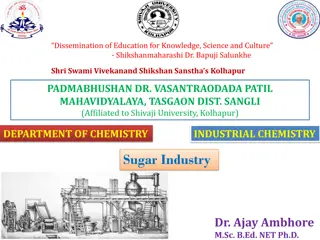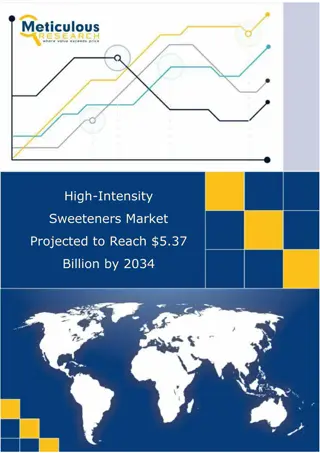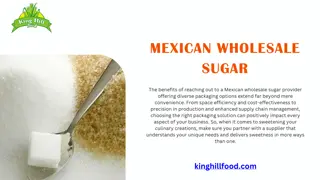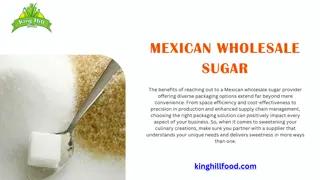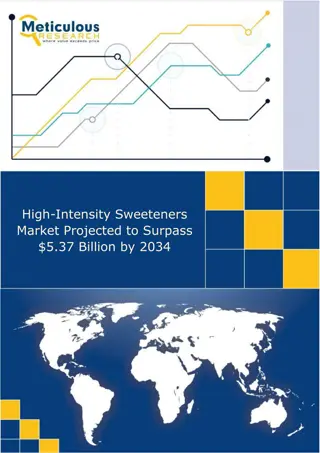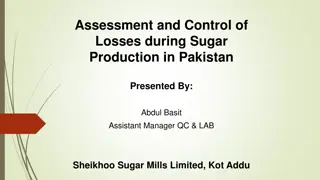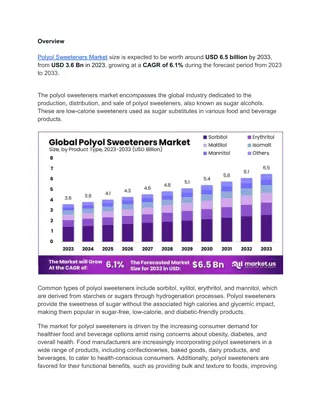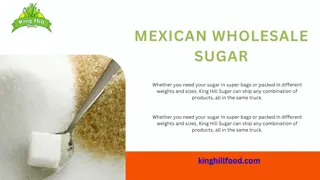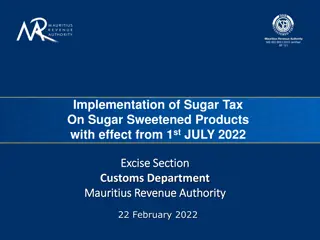Non-Sugar Sweeteners
Non-sugar sweeteners, also known as sugar substitutes or alternative sweeteners, play a crucial role in satisfying taste preferences and reducing added sugars. They are classified into bulk sweeteners and intense sweeteners, each with varying effects on dental health and metabolism. Taste buds, present before birth, respond differently to sugars, influencing taste preferences from early stages of life. Genetically linked taste perception and sweetness levels of different sugars further contribute to the complexity of taste sensations.
Download Presentation

Please find below an Image/Link to download the presentation.
The content on the website is provided AS IS for your information and personal use only. It may not be sold, licensed, or shared on other websites without obtaining consent from the author.If you encounter any issues during the download, it is possible that the publisher has removed the file from their server.
You are allowed to download the files provided on this website for personal or commercial use, subject to the condition that they are used lawfully. All files are the property of their respective owners.
The content on the website is provided AS IS for your information and personal use only. It may not be sold, licensed, or shared on other websites without obtaining consent from the author.
E N D
Presentation Transcript
Non- Sugar Sweeteners Dr. Rihab Abdul Hussein Ali B.D.S , M.Sc. , PhD.
Sweeteners are added sugars that are used as ingredients to both satisfy taste and in some cases provide added energy. Taste sensation is initiated by the arrival of a stimulus at the taste buds. Taste recognition occurs when the receptor sites of the cells of the taste buds carry, by cranial nerves, a qualitative and quantitative message to the brain. The messages are processed, and the stimulus is recognized as either sweet, sour, salty, or bitter, or some combination of these four.
The sweetness of sugars All sugar contributes sweetness to food, but the relative sweetening power varies among sugars. In general, the more easily the sugar dissolves in water the greater its sweetening power. For example, fructose is 75% sweeter than any other sugar. It is soluble in water; difficult to crystallize, as a result its expensive, it's useful in syrup. At the other extreme, the least sweet, least soluble sugar is lactose, because it is almost impossible to dissolve in the food to be sweetened. The taste is genetically linked, acquired in utero, neonatal, and influenced by visual, auditory, or taste stimuli during infancy, early childhood or even adulthood.
Taste buds are present and functioning before birth, a fact demonstrating by injecting sweetening agents into the amniotic fluid results in an increased rate of swallowing by the fetus. At birth, infants show a taste preference for sucrose, and their taste cells are more responsive to sucrose than other sugar and the newborn baby respond unfavorably to a bitter substance. It is important for both the therapist and the patient to know that sugar is available for bacteria in the plaque long after the sugar concentration in saliva has reached levels below the taste threshold for sugar.
Non- sugar sweeteners Sometimes referred to as sugar substitutes, sugar replacers or alternative sweeteners. Many research has been carried out in order to find sugar substitutes. When evaluating a non- sugar sweetener in relation to dental caries, it is important to consider the potential for metabolism by oral microorganisms and dental plaque, the influence of consumption on cariogenic microorganisms, and the risk of microbial adaptation to the sweetener. Sugar substitutes can be separated into two major groups: bulk sweeteners (nutritive, caloric) and intense sweeteners (non-nutritive, non-caloric), some of these are naturally occurring compounds. Grouping sweeteners as "nutritive" or "non-nutritive" acknowledges a difference in the amount of energy provided by the sweetener.
Bulk sweeteners (caloric) Many of the bulk sweeteners are sugar alcohols, and being chemically similar to sugars, they have a similar caloric content to sucrose, the most commonly known include sorbitol, mannitol, and xylitol. Because sorbitol and mannitol are only half as sweet as sucrose, there may be a tendency to increasecaloric intake with the use of these two compounds. Xylitol has the same sweetness as sucrose. Bulk sweeteners have similar physical characteristics as sucrose, and their substitution does not change the customary size and weight of a product (add volume and sweeteners to a product).
One of the disadvantages of the bulk sweeteners is that they are only partially absorbed in the small intestine and pass the colon where they may induce osmotic diarrhea. Bulk sweeteners are therefore not recommended for children under three years of age and care must taken with sugar-free medicines containing bulk- sweeteners, since high intakes cause gastrointestinal disturbance.
1- Sorbitol: It is used extensively as a non- sugar sweeteners in confectionery, chewing gum, liquid oral medicine, and toothpastes. The negative heat of dissolution is used advantageously in mints, which have pleasant cool taste. It is a derivative of glucose, occurs naturally in such fruits as apples, pears and peaches and in several vegetables.
It is not actively absorbed from the gastrointestinal tract and is absorbed at about one third of the rate of glucose absorption. This means that eating food rich in sorbitol allow blood glucose level to remain above the fasting level for a longer time than dose eating food correspondingly rich in glucose. Thus eating sorbitol may delay the onset of hunger. For this reason, sorbitol is an ingredient in some foods designed for use in weight reducing diets and has been used clinically as non-insulin stimulating carbohydrate, so used to be used in diabetic foods.
Sorbitol is less cariogenic than sucrose, as it fermented slowly by plaque organisms, and the rate is very much slower than that for glucose and sucrose. Sorbitol and sorbitol- containing products are considered safe for teeth but the oral microflora may adapt to sorbitol so that it loses its safety for teeth property. 2-Mannitol It is less popular than sorbitol, partly because of its higher price, and they have a similar dental properties. It is used in toothpaste, mouth rinses and as a dusting agent for chewing gum.
3-Xylitol It is the best nutritive sucrose substitute with respect to caries prevention. Xylitol considers as non-cariogenic and anti-cariogenic that prevent dental caries. It's non- fermentable in plaque and its saliva stimulating effect may support this statement. Xylitol may have an anti-microbial effect since the plaque accumulation after xylitol consumption is reduced and there is a good evidence that the ability of plaque to produce acids by metabolism of sugar reduced by xylitol. This seems to be explained adequately by the decrease in S. mutans in plaque exposed to xylitol and possibly a decreased in plaque quantity, xylitol have ability to inhibit growth and metabolism of S. mutans to the same degree as some antimicrobial. Microbiological studies have shown clearly that plaque organism did notadapt to metabolize xylitol.
Intense sweeteners (non-caloric) They are called intense sweeteners because they have sweetness hundreds to thousands of time than sucrose. These substances impart sweetness but furnish no calories (have a negligible energy value, or too little to have any clinical importance). An intense sweetener should permit caloric reduction without sacrificing palatability. The need for intense sweeteners is acute for primary preventive dentistry practices, a non-carious product that could be used in oral medication, mouth rinses, toothpaste and all form of candy is highly desirable. They are chemically very heterogeneous group, and are not chemically related to sugar.
They are not metabolized to acids by the oral microorganisms and they cannot cause dental caries. Thus, they are a perfect as far as dental caries is concerned. They are safe for teeth because they cannot act as an energy source for dental plaque microorganisms and acid cannot be derived However they have disadvantages in taste, stability, lack of volume, although a sweeteners with a low physical weight is also highly desirable for reducing the size of product packages. The most popular intense sweeteners are:
1-Saccharin: It is a considered approximately 300 time sweeter than sucrose. Due to its intense sweetness, the use of saccharin is only about 4% as costly as an equivalent sweetness derived from sucrose; it is compatible with most food and drug ingredients. It has a bitter taste in concentration over 0.1%, although the perception of this varies between individual. Saccharin has been reported to inhibit bacterial growth and metabolism but its caries inhibiting effects are small.
2-Aspartame: It is a dipeptide consisting of aspartic acid and phenylalanine. It is approximately 200 times sweeter than sucrose with a similar taste to sucrose. Individuals with phenylketonuria, who have a genetic defect of phenylalanine metabolism, should avoid ingestion of aspartame 3-Acesulfame K: It is approximately 200 times sweeter than sucrose. It has a pleasant sweet taste. Its sweetness is quickly perceptible and diminishes gradually without any unpleasant aftertaste. It is thought to have a good potential as a sweetener in most classes of food and drinks and useful sweetener in boiled sweet and preserves.
Protective factors in food Food and food component (dietary factors) that counteract the damaging effects of carbohydrates and have anti-cariogenic (caries inhibiting) properties are sometime referred to as cariostatic (protective) factors, fluorideare undoubtedly the most effective of these factors, other factors in food are : Phosphate: The possible caries inhibiting effect of various phosphates, which are found naturally in many foods. The most promising of the organic phosphates was phytate, identified as the most active substances in unrefined cereals. The effectiveness of phytate appears to be due to its ability to adsorb readily and firmly to enamel surfaces and so prevent the dissolution of enamel by acids.
However, the problem was that it was present naturally inside the bran particles and so was not readily available in its natural form, in the mouth. Therefore, to be effective, phytate would need to be extracted from grain and then used as food additive. However, this would not be desirable since phytate binds minerals calcium, magnesium, iron and zinc reduced their absorption from the gut, it probable that this side effect will make it unwise to recommend the use of phytate as a food additive.
Some investigators have found statistically significant reduction in caries increment by adding 1-3% of sodium phosphates or calcium sucrose phosphate to various foods or chewing gum, one major problem is that phosphate when added to sucrose, are cleared from saliva faster than sugar and fail to produce substantial increases in the phosphate concentration of human plaque. Other problems could possible risk of increased dental calculus formation or pathological calcification of internal organ.
Fats: Fats seems to reduce the cariogenicity of food, they may act merely by replacing carbohydrate in the diet. Fat may also form a protective barrier on the enamel, or surround the carbohydrates, making these less available and speeding up their removal from the mouth. Bacterial surface properties involved in plaque formation could also be altered by fats. Certain fatty acids have antimicrobial effect and have been shown to inhibit glycolysis in human dental plaque. Milk and cheese: Despite being one of the main sources of sugar in the diet of small children, normal milk consumption does not cause dental caries, and an inverse relationship between the consumption of milk and caries increment has been reported.
Milk is considered non- cariogenic or even anti-cariogenic in spite of the fact that lactose is fermented by dental plaque but its less acidogenic than other mono and disaccharides. On the other hand, milk has a combination cariostatic component in the readily available form: protein (casein), calcium and phosphate,calcium and phosphate that present in high concentration are able to prevent enamel demineralization. Human breast milk is higher in lactose and lower in phosphorus and calcium; however, the epidemiological studies have associated breast-feeding with low level of dental caries. Breast feeding provide no opportunity to added additional sugar to milk feeds and breast-fed infant are perhaps less likely to use baby bottles containing sugary liquids, however prolonged, and nocturnal suckling have been associated with increased caries risk .
The evidence from many studies shows that cows milk a non-cariogenic drink suitable for use as an artificial saliva in caries prone xerostomic patients, since it appear to have caries protective properties. Consuming cheesefollowing a sugary snack virtually abolish the usual fall on pH that is associated with sugars consumption. Cheese stimulates salivary secretion due to its sharp testing, the high protein (casein) calcium and phosphorus content seem to be another factor in the cariostatic mechanism of cheese as it increase their concentration in dental plaque, the calcium concentration within dental plaque strongly influences the balance between de- and remineralization of enamel. There is also increased evidence that chewing cheese may reduce the levels of cariogenic bacteria.
Fruit and dental caries Health report throughout the world encourage increased consumption of fruit and vegetables, also they reported that in order to reduce the risk of dental caries, consumption of non- milk extrinsic sugars should be decreased and that sugars should be replaced by fresh fruit, vegetables, and starchy food. It is also preferable to consume whole fresh fruit as opposed to juices, because their mastication provides a good stimulus to salivary flow, in addition fresh fruit juices contain non-milk extrinsic sugars, since liquidation release the fruit sugars from cellular structure of the fruit.
Testing food cariogenicity Dental caries is a result of demineralization brought about by frequent pH drops in the plaque. However, numerous studies have focused on methods to evaluate food cariogenicity, most often by the use of pH assessment of dental plaque exposed to the food items in question. There is no doubt that it's easy to rank the relative cariogrenic potential of a variety of foodstuffs by evaluating and comparing the Stephan curve derived when each foods are eaten under controlled condition. Ranking of food, according to their capacity to induce a pH drop in dental plaque should therefore only be considered as gross estimates of their relative cariogenicity.



